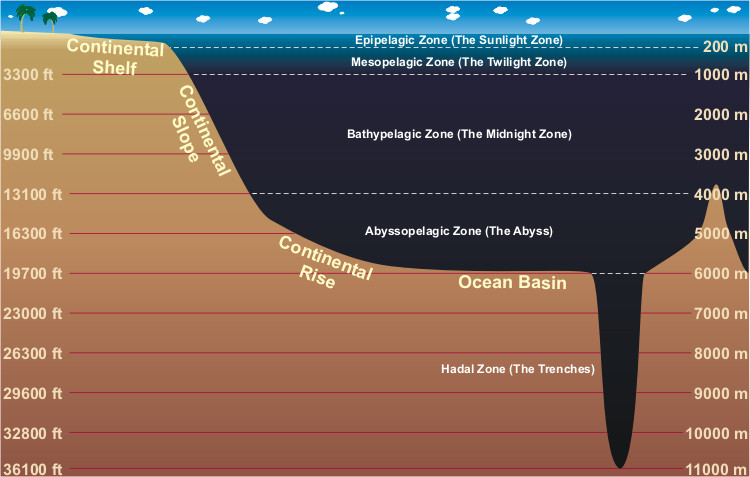9.3: Layers of the Ocean
- Page ID
- 12842
In 1960, two men in a specially designed submarine called the Trieste descended into a submarine trench called the Challenger Deep (10,910 meters). The average depth of the ocean is 3,790 m, a lot more shallow than the deep trenches but still an incredible depth for sea creatures to live in. There are three major factors that make the deep ocean hard to inhabit: the absence of light, lowtemperature, and extremely high pressure.

Vertical Divisions
To better understand regions of the ocean, scientists define the water column by depth. They divide the entire ocean into two zones vertically, based on light level. Large lakes are divided into similar regions. Sunlight only penetrates the sea surface to a depth of about 200 m, creating the photic zone (consisting of the Sunlight Zone and Twilight Zone). Organisms that photosynthesize depend on sunlight for food and so are restricted to the photic zone. Since tiny photosynthetic organisms, known as phytoplankton, supply nearly all of the energy and nutrients to the rest of the marine food web, most other marine organisms live in or at least visit the photic zone. In the aphotic zone (consisting of the Midnight Zone and the Abyss) there is not enough light for photosynthesis. The aphotic zone makes up the majority of the ocean, but has a relatively small amount of its life, both in diversity of type and in numbers.
Horizontal Divisions
The seabed is also divided into the zones described above, but the ocean itself is also divided horizontally by distance from the shore. Nearest to the shore lies the intertidal zone, the region between the high and low tidal marks. This hallmark of the intertidal is change, where water is in constant motions from ocean waves, tides, and currents. The land is sometimes under water and sometimes is exposed. The neritic zone is from low tide mark and slopes gradually downward to the edge of the seaward side of the continental shelf. Some sunlight penetrates to the seabed here. The oceanic zone is the entire rest of the ocean from the bottom edge of the neritic zone, where sunlight does not reach the bottom.
- Dynamic Earth: Introduction to Physical Geography. Authored by: R. Adam Dastrup. Located at: http://www.opengeography.org/physical-geography.html. Project: Open Geography Education. License: CC BY-SA: Attribution-ShareAlike
- Profile of the Ocean. Provided by: NOAA. Located at: http://oceanservice.noaa.gov/education/yos/resource/JetStream/ocean/oceanprofile.htm. License: Public Domain: No Known Copyright

